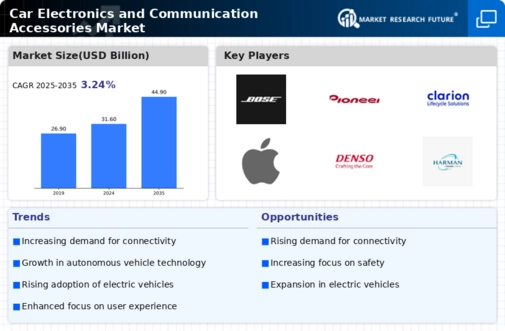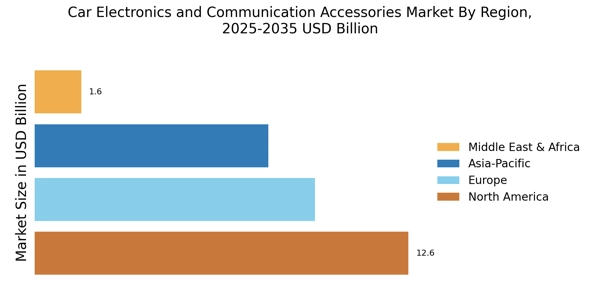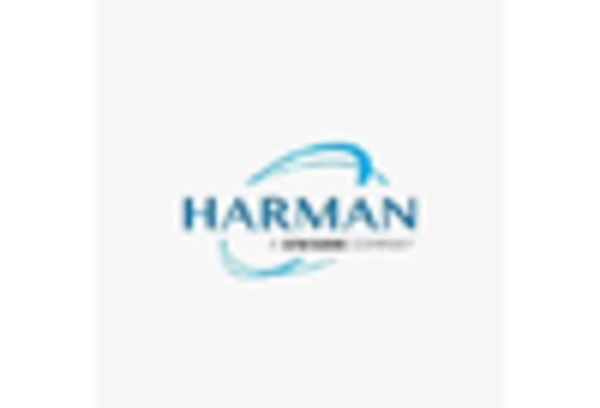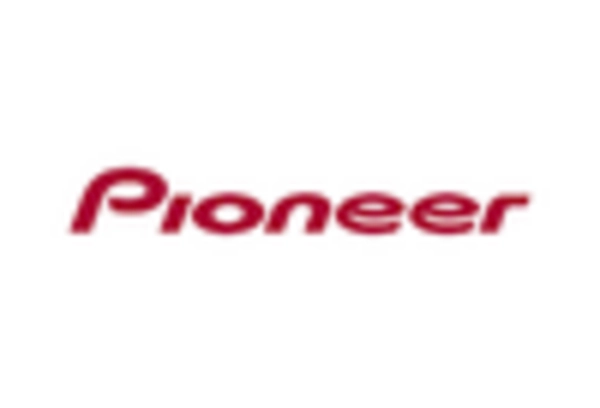Growth of Electric and Hybrid Vehicles
The Car Electronics and Communication Accessories Market is witnessing a transformation due to the growth of electric and hybrid vehicles. As these vehicles become more prevalent, the demand for specialized electronic components and communication accessories tailored to their unique requirements is increasing. In 2025, it is estimated that electric vehicles will account for over 25% of total vehicle sales, necessitating the development of advanced battery management systems, charging solutions, and integrated communication technologies. This shift not only supports environmental sustainability but also creates new opportunities for innovation within the Car Electronics and Communication Accessories Market.
Rising Demand for Connectivity Solutions
The Car Electronics and Communication Accessories Market is experiencing a notable surge in demand for connectivity solutions. As consumers increasingly seek seamless integration of their devices with vehicles, the market for Bluetooth, Wi-Fi, and other communication technologies is expanding. In 2025, the market for connected car technologies is projected to reach approximately 50 billion USD, indicating a robust growth trajectory. This demand is driven by the desire for enhanced user experiences, allowing drivers to access navigation, entertainment, and communication services effortlessly. Furthermore, the proliferation of smartphones and smart devices has created a symbiotic relationship between personal technology and automotive systems, further propelling the growth of the Car Electronics and Communication Accessories Market.
Advancements in Automotive Safety Technologies
The Car Electronics and Communication Accessories Market is significantly influenced by advancements in automotive safety technologies. With increasing regulatory pressures and consumer awareness regarding vehicle safety, manufacturers are integrating sophisticated electronic systems into vehicles. Features such as advanced driver-assistance systems (ADAS), collision avoidance systems, and lane-keeping assistance are becoming standard. The market for automotive safety electronics is expected to grow at a compound annual growth rate (CAGR) of around 10% through 2025. This trend not only enhances the safety of passengers but also contributes to the overall appeal of vehicles, thereby driving demand within the Car Electronics and Communication Accessories Market.
Regulatory Support for Technological Innovations
The Car Electronics and Communication Accessories Market is benefiting from regulatory support aimed at fostering technological innovations. Governments are increasingly implementing policies that encourage the adoption of advanced automotive technologies, including electronic safety features and communication systems. This regulatory environment not only promotes research and development but also incentivizes manufacturers to invest in cutting-edge technologies. As a result, the market for car electronics is expected to grow steadily, with projections indicating a potential increase of 15% in market size by 2025. This supportive framework is crucial for the evolution of the Car Electronics and Communication Accessories Market, as it aligns with broader goals of enhancing vehicle safety and efficiency.
Consumer Preference for Enhanced In-Car Experience
The Car Electronics and Communication Accessories Market is significantly shaped by consumer preferences for enhanced in-car experiences. As consumers increasingly prioritize comfort and entertainment during travel, there is a growing demand for high-quality audio systems, infotainment solutions, and connectivity features. The market for in-car entertainment systems is projected to reach approximately 30 billion USD by 2025, reflecting a shift in consumer expectations. This trend is further fueled by the rise of streaming services and mobile applications, which necessitate advanced communication accessories that can seamlessly integrate with vehicle systems. Consequently, manufacturers are compelled to innovate and enhance their offerings within the Car Electronics and Communication Accessories Market.


















Leave a Comment